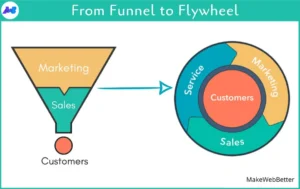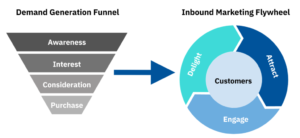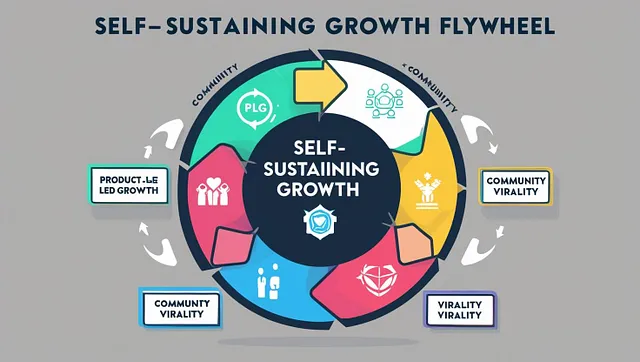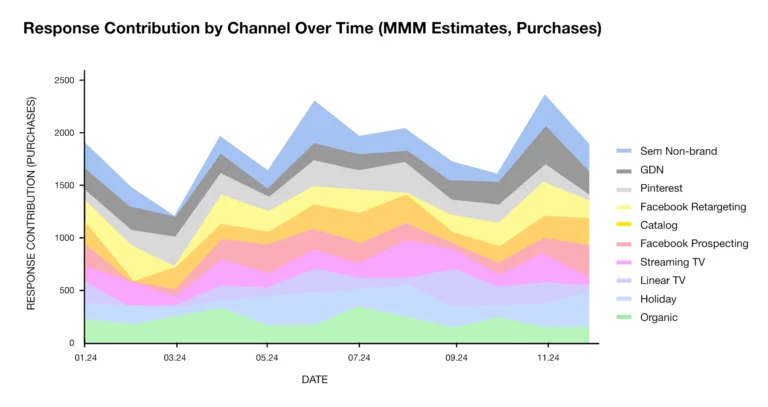In the fast-evolving world of digital marketing, traditional funnel-based models are losing their effectiveness. Brands need a new approach that focuses on momentum and long-term customer relationships rather than just quick lead generation.
Enter the Marketing Flywheel – a self-sustaining growth engine that fuels continuous success.
Unlike the traditional sales funnel that ends with a purchase, the flywheel business model keeps customers engaged, transforming them into brand advocates who drive organic growth.
In this guide, we’ll explore what a flywheel is, how to implement it, and how top brands use this model to scale sustainably.
What Is a Marketing Flywheel?
The Marketing Flywheel Model is a circular system where the energy and momentum from customer interactions drive new business growth. Unlike the linear funnel, where prospects move from awareness to purchase and then drop off, the flywheel leverages existing customers to attract new ones, creating a continuous growth loop.
How the Flywheel Works:
Attract – Drive high-value leads through content, SEO, and thought leadership.
Engage – Convert prospects with seamless user experiences and relationship-building.
Delight – Turn customers into advocates by delivering exceptional experiences.
Instead of losing momentum when a customer makes a purchase, the marketing flywheel keeps spinning, generating more business through word-of-mouth, referrals, and repeat sales.
Why the Marketing Flywheel Outperforms Funnels

1. Customer-Centric Growth
Funnels focus on transactions; the flywheel model focuses on retention and loyalty. This approach builds stronger, long-term customer relationships.
2. Organic Momentum & Compounding Effects
A self-sustaining growth engine creates exponential results over time, reducing dependency on paid advertising (flywheel advertising) while increasing ROI.
3. Lower Customer Acquisition Costs (CAC)
Happy customers become free marketing agents, promoting your brand through referrals and UGC (User-Generated Content), slashing CAC.
4. Higher Lifetime Value (LTV)
Repeat purchases and ongoing engagement increase the customer lifetime value, making each acquisition more profitable.
How to Build Your Marketing Flywheel?
Implementing a flywheel business model requires a strategic approach.

Here’s how you can start:
Step 1: Attract the Right Audience
Utilize SEO and content flywheel strategies to create evergreen, high-value content.
Optimize landing pages to rank for flywheel machines and what is a flywheel search.
Leverage organic & paid flywheel advertising on platforms like Meta and Google.
Step 2: Engage & Convert with Value
Use personalized email sequences and automation.
Offer frictionless user experiences with optimized CTAs and checkout flows.
Build trust with case studies and testimonials.
Step 3: Delight & Retain Customers
Provide post-purchase support, loyalty programs, and exclusive offers.
Encourage and amplify user-generated content.
Implement referral programs to drive organic word-of-mouth.
Case Studies: Brands That Mastered the Flywheel
1. Amazon: The Ultimate Flywheel Machine
Amazon’s entire business is built on a marketing flywheel model:
Attracts with competitive pricing and wide product availability.
Engages through Prime memberships, personalized recommendations, and an easy checkout process.
Delights by offering fast shipping, seamless returns, and excellent customer service.
2. HubSpot: B2B Flywheel Model
HubSpot shifted from a funnel-based model to a content** flywheel** approach:
Attracts with high-quality content and SEO.
Engages through free tools and inbound marketing strategies.
Delights with educational resources, certifications, and an active community.
Common Mistakes & How to Avoid Losing Momentum
While the flywheel concept is powerful, many brands fail due to execution mistakes. Here’s how to avoid common pitfalls:
- ❌ Focusing only on lead generation: Don’t ignore retention strategies like loyalty programs and community-building.
- ❌ Neglecting customer experience: Ensure your self-sustainable growth engine is fueled by happy customers.
- ❌ Underestimating organic reach: Content and referrals should be core to your flywheel advertising efforts.
- ❌ Not measuring momentum: Track key performance indicators (KPIs) like engagement rates, repeat purchase rates, and referral contributions.
Measuring Success & Optimizing Over Time
To ensure your flywheel keeps spinning, regularly measure:
- Customer Lifetime Value (CLV)
- Referral traffic & organic growth
- Churn rate & retention
- Customer satisfaction (NPS scores)
Use a blend of qualitative feedback and quantitative data to tweak strategies and optimize for long-term success.
Conclusion:
It’s time to shift from funnels to Flywheels for sustainable growth. In 2025 and beyond, brands that adopt the marketing flywheel model will dominate. Instead of chasing one-time conversions, a flywheel business model builds a self-sustaining growth engine that compounds over time.
By focusing on attraction, engagement, and delight, businesses can create a system that fuels itself, leading to higher profitability, lower acquisition costs, and long-term scalability. Ready to implement your flywheel? Start by optimizing your customer experience, engaging with value-driven content, and leveraging your existing audience to fuel your next stage of growth!



